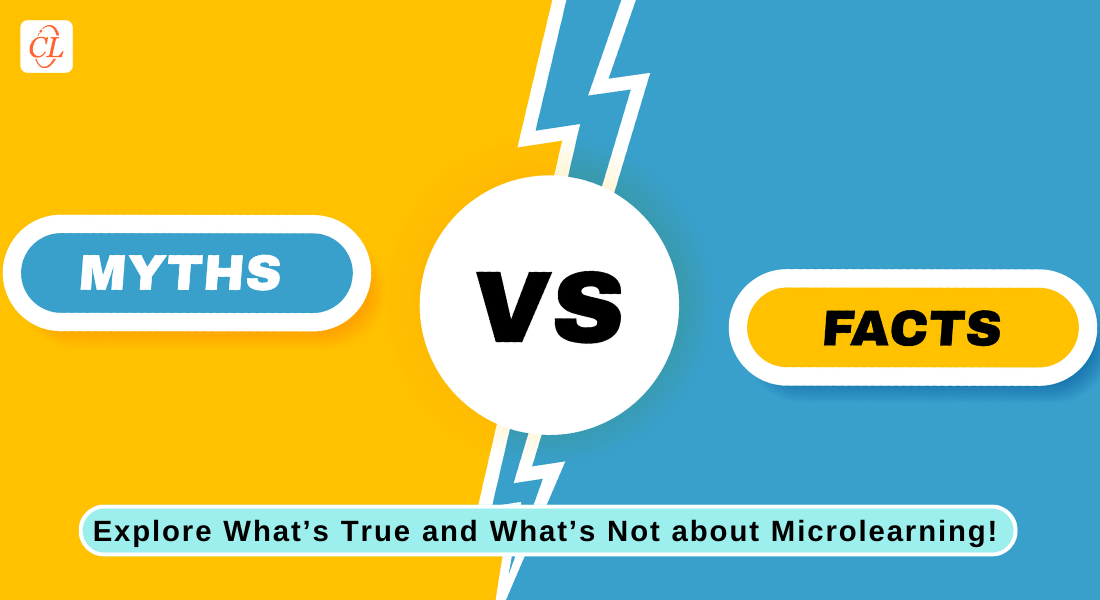Common Microlearning Myths Dispelled!

The popularity of microlearning as a new-age tool is on the rise with the ever-increasing time-crunch that learners face and also the proliferation of technology such as smartphones and video games. It is used to provide learning that is bite-sized in place of long, tedious sessions. But before you jump on the microlearning bandwagon, there are certain concepts and myths that need to be clarified.
What is Microlearning?
Microlearning is a training technique adopted by organizations to provide contextual learning that is easily accessible, in easily digestible bite-sized pieces. It can be incorporated into the lives of your employees, enabling them to engage better with the content and retain vital information.
What are the Characteristics of Microlearning?
- Short: Each module should be kept short and crisp, ideally within a time frame of 3-8 minutes.
- Focused: Each module should cover one topic or learning objective.
- Easily accessible: Learners should be able to access the learning content across different platforms.
Although the benefits of microlearning are known, misconceptions regarding the concept are quite frequent as well. Read on to know and dispel some of the common myths surrounding microlearning.
1. It’s all about content chunking
One of the most common myths is that eLearning professionals merely divide the content into smaller modules to develop microlearning. However, it is much more than that. It is a process that includes presenting the content in a different and effective way. Content chunking is just one aspect of microlearning.
Each module should focus on the core ideas of one concept or sub-topic and fulfill one learning objective. The prime idea being that, content should be easier for the learner to understand after it is chunked. If the content is fragmented and unorganized, the whole purpose of microlearning is lost.
2. Applies to all situations
Microlearning can be used to cover a lot of subject, but there are a few where it might not be ideal. For instance, new languages cannot be expected to be picked up by employees only by seeing bite-sized modules or videos. Or mastering any software will require constant practice over time, and cannot be replaced with anything which is less satisfactory. Therefore, there are certain skills where microlearning will not fit well and won’t be as effective as it is in other skills.
3. Works on a set time frame
Wondering if an eLearning module which is a few minutes long can be called microlearning? It cannot be classified as microlearning if it fails to deliver one complete learning point, i.e., delivers content aligned to one learning objective.
Although microlearning is meant to be short, the actual length depends on the content and learning objective. A unit can only be considered complete when the learning objective for that unit is met.
4. Not ideal for complex topics
Another myth about microlearning is that it is not meant for teaching complex topics. However, Microlearning resources can be created that can help reinforce concepts and ideas for even complex topics. Here are a few microlearning formats that can reinforce key topics:
- Tutorial Videos: Once you are done with introductory sessions on a certain topic, microlearning can be used to provide task tutorials which highlight each step involved in the process or each concept required to be learned.
- Job-aids: It can include microlearning simulations, interactive infographics, or simple scenario-based learning that can help learners learn and reflect on how to apply the learning on-the-job.
- Demonstrations: Microlearning nuggets about the overview of a product, its features, selling points, etc.
5. Replacement for eLearning
Microlearning is a powerful tool for reinforcing lessons and provides learners with key-takeaways, but usually cannot be a replacement for eLearning course. It can be used as to aid the comprehension of learners. Hence, it cannot be taken as a standalone resource. In order to get in-depth knowledge, learners will have to go back to the eLearning course.
6. Ideal only for reinforcement
While it might look as though microlearning is only ideal for reinforcement, it can be used to teach too. Learners with shorter attention spans will find microlearning easier to learn than going through tedious courses. Teaching through microlearning can be beneficial in areas of compliance courses, product training, etc. Also, it can be incorporated in blended learning programs.



![6 Microlearning Myths Debunked [Infographic]](https://blog.commlabindia.com/hubfs/Imported_Blog_Media/microlearning-features-for-corporate-training-infographic-1.jpg)

![What Microlearning Is and What It Isn’t! [Infographic]](https://blog.commlabindia.com/hubfs/Imported_Blog_Media/microlearning-quick-reference.png)